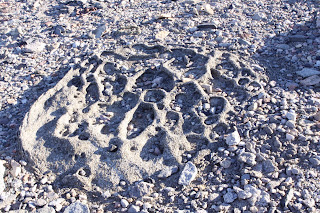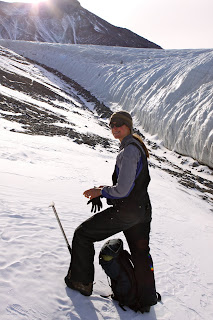
Lake Frixel and the mouth of the Taylor Valley
While I was out on my hikes over our one day weekend, we lost two of our connections, Internet and phone, to the outside world. We weren't worried because we still had our radio and Iridium phone and the Comms guys could fix them on Monday. In order to use less resources, the Comms shop and my boss (Thank you, Karen and Bill!) decided they would keep me at the field camp for a few extra hours to troubleshoot the problem from Lake Hoare while the Comms guys went to Voslips, the location of the mountain top repeater, to troubleshoot the problem from there. Instead of having one of the first flights out Monday morning, I'd be waiting until late afternoon.

A ventifact.

Use your imagination and see a hand.

Another ventifact.
Only an hour or two after that decision was made, the weather deteriorated at McMurdo and all helicopter flights were canceled for the day. That left me stranded in the Dry Valleys for one more night! My two day trip, turned three day trip, had become a four day trip! Fortunately for me, it was a blue bird day on my side of McMurdo Sound at Lake Hoare. I did camp chores during the day and was set loose to hike Andrew's Ridge in the late afternoon.

Andrew's Ridge.

Glacier demolished ground?
Hiking Andrew's Ridge was amazing. After crossing Lake Hoare, I walked straight up to the ridge line. From there, I just headed west towards Lake Bonnie, the polar plateau, and the area above the defile that I had hiked to earlier. Along the way, the terrain changed drastically. Near the top of the ridge, there was almost no snow and most of the rocks look like they had been smashed to smithereens. Because the area was so flat, I assumed a glacier had ground up the large rocks and then receded. However, it might have been sand and wind erosion over thousands of years. I don't know. The few large rocks left behind were all ventifacts that had been eroded down by the sand. It was incredible to witness.

A ventifact.

More ventifact.
About halfway through my jaunt along Andrew's Ridge, I noticed myself looking for terrestrial wildlife. There was none. There isn't any terrestrial wildlife in Antarctica, only avian and aquatic wildlife. I think I almost forgot I was in Antarctica because it was so warm and I wasn't waking on any ice. It was similar scenery to a summer alpine hike in Colorado. When I finally remembered I was in Antarctica, it really struck me just how out of place the Dry Valleys are. There should be ice everywhere, but there isn't. Parts of them are almost barren of snow.

Another ventifact.

More ventifact.
Along the way, my black fleece jacket fell off my backpack. I was really worried because you aren't supposed to leave ANYTHING behind in the Dry Valleys. I was peeing in a bottle, swallowing my saliva, and even wiping my nose on my sleeve instead of using a farmer's blow or snot rocket. If I went back, I wasn't sure I'd find it because it blended into the terrain and there wasn't an exact trail to follow. I'd been trying to walk rock to rock so I wouldn't leave any footprints behind. Apparently, they can last for years. There are tire tracks from the 1960s that haven't eroded away yet in another part of the valleys. I went back about a half mile, got lucky, and spotted it. When I got back to camp, Rae told me about a shirt of hers than had been lost and recovered four years later! I don't think she is still wearing it.

Lake Bonnie and the spot where I dropped down to Mummy Lake.

Yet another ventifact.
While I was walking on this hike there wasn't even a strong breeze to generate any noise other than the swooshing of my own jacket. If I stopped, there was nothing to hear. Nothing, but silence. So much nothing, that I pulled my hood down to better hear the sound of silence.

Seuss Glacier

Not so mummified seal on the north shore of Lake Hoare (maybe Chad).

































